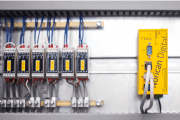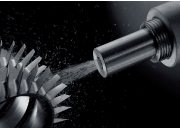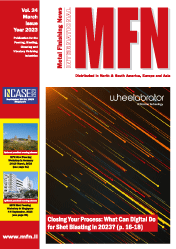Digital technology for shot blast processes has evolved at pace in 2022, with new tools becoming available to easily digitalize existing equipment and tackle the big cost drivers of operating shot blast equipment: abrasive consumption, energy use and wear/maintenance. The next frontiers include an even tighter grip on hard-to-control process parameters and a focus on sustainability.
At Wheelabrator, a dedicated team translates the latest digital advances into tools that solve blast machine operators’ real-life challenges, whether it’s hitting the limits of conventional process optimization, controlling energy use in times of high prices, enabling predictive maintenance or future-proofing machines for the digital age.
We spoke to Heinrich Dropmann, Senior Vice President Global Wheel at Wheelabrator, about what’s in store for digitally supported shot blasting in 2023 and what solutions are customers looking for.
(?) MFN: Heinrich, perhaps you could start by recapping the progress in digital shot blasting last year? What’s been driving adoption?
(!) H. D.: The first four tools we made available to customers over the last 18 months were deliberately designed to focus on the biggest cost drivers of running a shot blast machine: energy cost, abrasive consumption, maintenance and overall machine effectiveness. We wanted to make it easy for machine owners to go digital – by addressing issues that cost them money. That way, there’s a clear business case for digitally enabling a machine.
The steep rise in energy cost last year has driven digital adoption across the board. Our colleagues at our sister brands in moulding, die casting and melting have been seeing the same. In light of such a sudden, sharp increase in cost, digitization is a fast, cost-effective solution to tackle energy consumption.
The biggest hurdle to adoption is still about getting equipment owners to make that first step. In our pilots and first customers projects we’ve found that, once a machine is digitally enabled and people start using their first digital tool, they learn quickly, see the benefits and start wanting to build their own dashboards or have ideas for new tools. That’s why we wanted to make it as easy as possible to deploy digital tools on existing machines, with cost-effective digital upgrades and tools that make a difference quickly.
We’ve got some very sophisticated pilot customers, who have embraced the potential of digital technology for their blast process. So while external pressures helped drive adoption in 2022, we’re now seeing customers driving adoption of new tools from within.
(?) MFN: Why should blast machine owners consider the digitization of their process?
(!) H. D.: The shot blast process has been a black box for too long. We’ve made significant progress over the last two decades controlling everything we can control without really being able to look inside that black box. But we’ve reached the limits in terms of process improvements and precision we can achieve that way.
With digitization, we can open the black box, track process parameters we’ve never been able to track before, in real time, and analyse the complex interdependencies between them to unlock new room for improvement.
That’s the real step change, but there’s also a simple productivity advantage that can’t be underestimated. If you want to check and record a specific parameter conventionally, even if it’s one you can access without new digital systems in place, you have to walk up to the machine, take a look, note it down. That’s hugely inefficient. Even the simplest digital tools capture and record process data automatically in real time and bring them all together in one place, ready for analysis, without having to walk up to the PLC.
Our tool for Overall Equipment Effectiveness, for example, makes things visible at a glance, and that could technically be observed without digital help: what has caused idling, why is there always a hold-up at unloading, and what’s happening upstream and downstream of the machine. That’s hugely valuable information if you want to improve the efficiency of your production, but it’s hard to capture and assess manually.
In summary, digitizing the blast process will save cost on specific blast machine issues in the short term, but will quickly have wider benefits. The potential for improving productivity, capacity and quality is significant.
(?) MFN: What happens beyond adopting a specific tool? Do operators need to bring special expertise in house to fully utilize a digitally enabled machine?
(!) H. D.: It’s important that the people in-house, who understand the process and their production, can shape the digital tools they use. That’s why we have made a sizeable investment in our Monitizer platform again last year, specifically to make it more user-friendly and more accessible to machine operators. It’s now incredibly easy to build your own dashboards and do more with the data you are collecting from your blast process.
The way we develop our digital tools at Wheelabrator, as a close collaboration between shot blast experts, customers and the digital experts from the Monitizer team, means the IT knowledge is baked into the platform, along with deep process understanding.
When we deploy our tools at our customers, this three-way collaboration continues, resulting in a steep learning curve and quick knowledge transfer to the customer team. In our experience, the in-house teams then learn very quickly and start coming up with their own ideas and tools.
(?) MFN: What are blast machine users interested in building?
(!) H. D.: Most blast machine users want to configure or build their own dashboards to reflect their exact needs and requirements. They can build in thresholds and alerts, track and combine parameters. But we’ve also had pilot partners who want to zoom into specific parts of the process and work with us to advance the technology.
A good example is a customer who has been using our Monitizer solution to enhance process precision and output quality. They wanted to get a tight handle on abrasive condition, ensuring a perfect operating mix at all times, as they’ve found it had a big impact on quality.
We’ve worked with them to track the right parameters, installing new optical sensors or coming up with proxy measures. We’re now working with them to take abrasive monitoring to the next level, developing real-time visual analysis of the abrasive for even tighter process control and a potentially significant impact on output quality.
Another theme we’re seeing is sustainability: customers are increasingly using digital tools to make processes more sustainable (saving energy and resources, reducing waste, etc.), but also to track, improve and evidence the energy use, carbon footprint and resource efficiency of their process.
The team at MAT Foundry is using Monitizer on its Wheelabrator machines as well as their DISA moulding lines to track, report and drive down emissions. For example, they use digital tools to steadily reduce cycle times on their shot blast equipment to save energy (in addition to reducing wear and abrasive consumption).
(?) MFN: How important is it to integrate whatever digital system you have on your blast machine with other IIoT systems in an operation?
(!) H. D.: We believe it should be able to integrate with other systems, which is why our platform is equipment-agnostic and offers high interoperability. At the same time, we design digital tools that deliver value on their own, just by improving the blast process. That’s important for driving adoption. The benefits must be there from day one, not just once everything is connected.
However, joining up data across a whole site, whether it’s a foundry or any other manufacturing set-up, can be incredibly powerful and we want our customers to have that option. For example, data from the blast machine can indicate things are going wrong elsewhere and gathering data from every part of the process, opening up new possibilities for root cause analysis.
Our philosophy is to provide the ability to start small and scale fast. MAT Foundry is a good example of a customer who has been using Monitizer across shot blast and moulding equipment (using powerful foundry tools from our sister brand DISA as well as ours to connect and monitor a whole process end to end). All Norican brands are built on the same powerful platform, so it’s particularly easy to connect processes for customers who use those technologies, but our system happily works with all sorts of other set-ups as well.
(?) MFN: You mentioned sustainability as an emerging theme earlier. Are there any other ways in which digitization can support sustainability drives, beyond monitoring and reducing energy use?
(!) H. D.: An obvious area is reducing travel for service and maintenance. We have just launched our Remote Smart Service (RSS) offering, which enables very fast troubleshooting and maintenance through remote support from Wheelabrator experts, and that’s not just about reducing travel. Troubleshooting more effectively and faster has a knock-on effect on how efficiently and sustainably a facility is used. You could have less wear, fewer faults, a more effective use of each shift.
We’re also starting to see pressure on our customers from their customers to clean up their act and prove sustainable operations. In automotive especially, the big manufacturers are already taking a closer look at how sustainably their suppliers are producing; now, it is the time to get a digital handle on sustainability performance, and improve commercial performance at the same time!
(?) MFN: What are the next big opportunities in digital blasting?
(!) H. D.: For those who have already started using digital tools, the opportunities are in further refining the data picture by adding more sophisticated sensors. We’ve got tools in development that keep an eye on specific, key components to prevent failure and reduce wear. We’re also working on tools that display the real-time cost per component or batch and per blast cycle. Some of our customers are also working towards a self-correcting process, for abrasive condition, for example.
A major area of development is to dramatically enhance process control of precision processes like shot peening. We’re looking at a whole range of parameters and data points here that we can capture and control. An important feature here is to record the exact process parameters for each part and save it for retrospective analysis and audit.
Other opportunities are in using AI to supercharge data analysis, but also to start offering up suggestions for process improvements. This is even more powerful, if data is joined up across sub-processes and across machines. We’ve only just started opening up the black box that is the shot blast process – the potential is huge; technology is moving fast.
(?) MFN: How can blast machine owners and shot blast professionals keep up with those developments?
(!) H. D.: Simply by making a first step on their digital journey. Most IIoT systems are capable of evolving. For example, we’ve invested heavily in our platform to make it flexible, adaptable and equipment-agnostic. It can take our blast machine owners and operators from the very basics right through to advanced applications and the use of AI.
The learning curve we have seen in some of our pilot projects is incredible, which shows the power of giving people great tools. In using them, they will understand what’s possible and will quickly be able to adopt some of the most advanced digital technology out there. We see it as our role to get that technology ready and relevant to everyday shot blasting practice.
(?) MFN: Heinrich – thank you for your time!
MFN would like to thank Heinrich
Dropmann for this interview!
For Information:
Wheelabrator Group GmbH
Industriestraße 55
48629 Metelen, Germany
Tel. +49.2556.880
E-mail: kontakt@wheelabratorgroup.de

































